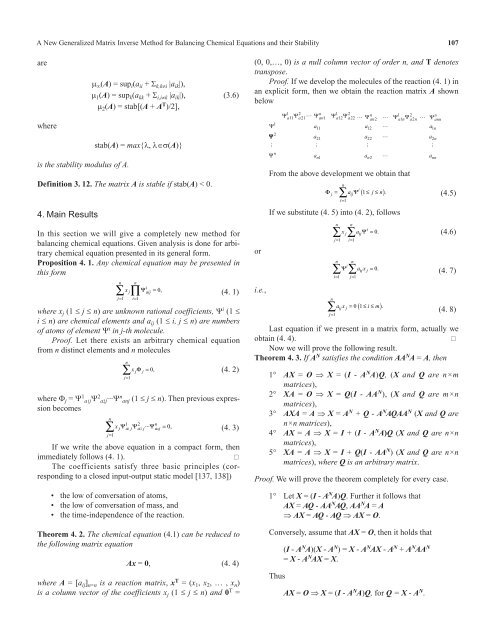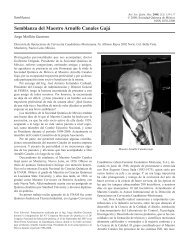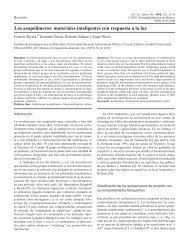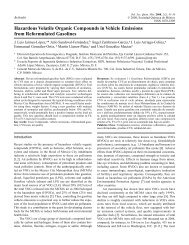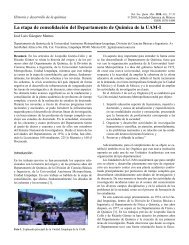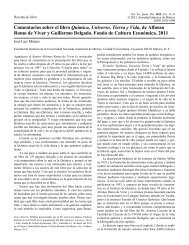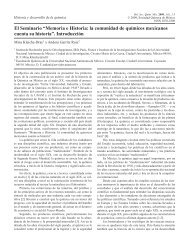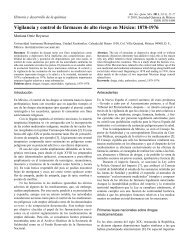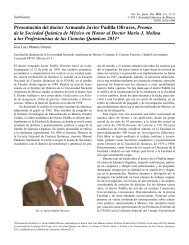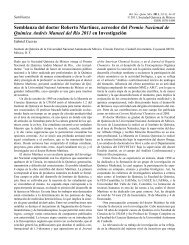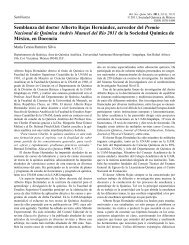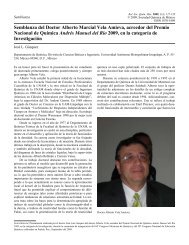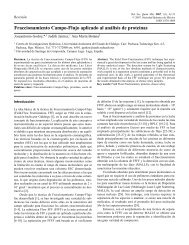A New Generalized Matrix Inverse Method for Balancing Chemical ...
A New Generalized Matrix Inverse Method for Balancing Chemical ...
A New Generalized Matrix Inverse Method for Balancing Chemical ...
Create successful ePaper yourself
Turn your PDF publications into a flip-book with our unique Google optimized e-Paper software.
A <strong>New</strong> <strong>Generalized</strong> <strong>Matrix</strong> <strong>Inverse</strong> <strong>Method</strong> <strong>for</strong> <strong>Balancing</strong> <strong>Chemical</strong> Equations and their Stability 107<br />
are<br />
where<br />
m ∞ (A) = sup i (a ii + S k,k≠i |a ik |),<br />
m 1 (A) = sup k (a kk + S i,i≠k |a ik |), (3.6)<br />
m 2 (A) = stab[(A + A T )/2],<br />
stab(A) = max{l, l∈s(A)}<br />
(0, 0,…, 0) is a null column vector of order n, and T denotes<br />
transpose.<br />
Proof. If we develop the molecules of the reaction (4. 1) in<br />
an explicit <strong>for</strong>m, then we obtain the reaction matrix A shown<br />
below<br />
is the stability modulus of A.<br />
Definition 3. 12. The matrix A is stable if stab(A) < 0.<br />
4. Main Results<br />
In this section we will give a completely new method <strong>for</strong><br />
balancing chemical equations. Given analysis is done <strong>for</strong> arbitrary<br />
chemical equation presented in its general <strong>for</strong>m.<br />
Proposition 4. 1. Any chemical equation may be presented in<br />
this <strong>for</strong>m<br />
n n<br />
∑ x i<br />
j ∏ aij = 0<br />
j= 1 i=<br />
1<br />
Ψ ,<br />
(4. 1)<br />
where x j (1 ≤ j ≤ n) are unknown rational coefficients, Ψ i (1 ≤<br />
i ≤ n) are chemical elements and a ij (1 ≤ i, j ≤ n) are numbers<br />
of atoms of element Ψ i in j-th molecule.<br />
Proof. Let there exists an arbitrary chemical equation<br />
from n distinct elements and n molecules<br />
n<br />
∑ x j j = 0<br />
j=<br />
1<br />
Φ , (4. 2)<br />
where Φ j = Ψ 1 a1jΨ 2 a2j···Ψ n anj (1 ≤ j ≤ n). Then previous expression<br />
becomes<br />
n<br />
1 2<br />
∑ x j Ψa j a j a n<br />
1<br />
Ψ<br />
2<br />
Ψ<br />
n j = 0<br />
j=<br />
1<br />
... , (4. 3)<br />
If we write the above equation in a compact <strong>for</strong>m, then<br />
immediately follows (4. 1).<br />
<br />
The coefficients satisfy three basic principles (corresponding<br />
to a closed input-output static model [137, 138])<br />
• the low of conversation of atoms,<br />
• the low of conversation of mass, and<br />
• the time-independence of the reaction.<br />
Theorem 4. 2. The chemical equation (4.1) can be reduced to<br />
the following matrix equation<br />
Ax = 0, (4. 4)<br />
where A = [a ij ] n×n is a reaction matrix, x T = (x 1 , x 2 , … , x n )<br />
is a column vector of the coefficients x j (1 ≤ j ≤ n) and 0 T =<br />
or<br />
i.e.,<br />
From the above development we obtain that<br />
n<br />
i<br />
Φ j = ∑aijΨ<br />
1 ≤ j ≤ n<br />
i=<br />
1<br />
If we substitute (4. 5) into (4. 2), follows<br />
n n<br />
i<br />
∑ x j∑aijΨ = 0<br />
j=<br />
1 i=<br />
1<br />
n n<br />
∑Ψ i ∑aij x j = 0<br />
i=<br />
1 j=<br />
1<br />
n<br />
∑aij<br />
x j = 0 ( 1 ≤ i ≤ m)<br />
.<br />
j=<br />
1<br />
( ). (4.5)<br />
. (4.6)<br />
.<br />
(4. 7)<br />
(4. 8)<br />
Last equation if we present in a matrix <strong>for</strong>m, actually we<br />
obtain (4. 4).<br />
<br />
Now we will prove the following result.<br />
Theorem 4. 3. If A N satisfies the condition AA N A = A, then<br />
1° AX = O ⇒ X = (I - A N A)Q, (X and Q are n×m<br />
matrices),<br />
2° XA = O ⇒ X = Q(I - AA N ), (X and Q are m×n<br />
matrices),<br />
3° AXA = A ⇒ X = A N + Q - A N AQAA N (X and Q are<br />
n×n matrices),<br />
4° AX = A ⇒ X = I + (I - A N A)Q (X and Q are n×n<br />
matrices),<br />
5° XA = A ⇒ X = I + Q(I - AA N ) (X and Q are n×n<br />
matrices), where Q is an arbitrary matrix.<br />
Proof. We will prove the theorem completely <strong>for</strong> every case.<br />
1° Let X = (I - A N A)Q. Further it follows that<br />
AX = AQ - AA N AQ, AA N A = A<br />
⇒ AX = AQ - AQ ⇒ AX = O.<br />
Conversely, assume that AX = O, then it holds that<br />
Thus<br />
(I - A N A)(X - A N ) = X - A N AX - A N + A N AA N<br />
= X - A N AX = X.<br />
AX = O ⇒ X = (I - A N A)Q, <strong>for</strong> Q = X - A N .


